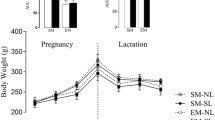Abstract
Exercise improves cardiovascular fitness, plasma lipids, and insulin response in lactating women. However, exercise alone, without caloric restriction, does not promote weight loss. Once lactation is established, over-weight women may restrict their energy intake by 500 kcal/day to promote a weight loss of 0.5 kg/week without affecting the growth of their infants. Moderate exercise does not affect maternal immune status or levels of slgA, lactoferrin, and lysozyme in human milk. Further research is needed to determine the effect of exercise and energy restriction on maternal bone health and immune status and composition of human milk.
Access this chapter
Tax calculation will be finalised at checkout
Purchases are for personal use only
Preview
Unable to display preview. Download preview PDF.
Similar content being viewed by others
References
Butte NF, Hopkinson JM. Body composition changes during lactation are highly variable among women. J Nutr 1998;128:381S–385S.
Cross NA, Hillman LS, Allen SH, Krause GF. Changes in bone mineral density and markers of bone remodeling during lactation and postweaning in women consuming high amounts of calcium. J Bone Miner Res 1995;10:1312–1320.
Dewey KG, Lovelady CA, Nommsen-Rivers LA, McCrory MA, Lonnerdal B. A randomized study of the effects of aerobic exercise by lactating women on breast-milk volume and composition. N Engl J Med 1994;330:449–453.
Drinkwater BL, Chesnut CH. Bone density changes during pregnancy and lactation in active women: a longitudinal study. Bone Miner 1991;14:153–160.
Flegal KM, Carroll MD, Ogden CL, Johnson CL. Prevalence and trends in obesity among US adults, 1999–2000. JAMA 2002;288:1723–1727.
Gregory RL, Wallace JP, Gfell LE, Marks J, King BA. Effect of exercise on milk immunoglobulin A. Med Sci Sports Exerc 1997;29:1596–1601.
Gunderson EP, Abrams B, Selvin S. The relative importance of gestational gain and maternal characteristics associated with the risk of becoming overweight after pregnancy. Int J Obes 2000;24:1660–1668.
Hayslip CC, Klein TA, Wray HL, Duncan WE. The effects of lactation on bone mineral content in healthy postpartum women. Obstet Gynecol 1989;73:588–592.
Hyung RN, Daniels LC, Seelig LL. Preliminary study of how alcohol consumption during pregnancy affects immune components in breast milk and blood of postpartum women. Alcohol Alcohol 1997;32:581–589.
Kalkwarf HJ, Specker BL. Bone mineral loss during lactation and recovery after weaning. Obstet Gynecol 1995;86:26–32.
Little KD, Clapp JF. Self-selected recreational exercise has no impact on early postpartum lactation-induced bone loss. Med Sci Sports Exerc 1998;30:831–836.
Lovelady CA, Lonnerdal B, Dewey KG. Lactation performance of exercising women. Am J Clin Nutr 1990;52:103–109.
Lovelady CA, Nommsen-Rivers LA, McCrory MA, Dewey KG. Effects of exercise on plasma lipids and metabolism of lactating women. Med Sci Sports Exerc 1995;27:22–28.
Lovelady CA, Garner KE, Moreno KL, Williams JP. The effect of weight loss in overweight, lactating women on the growth of their infants. N Eng J Med 2000;342:449–453.
Lovelady CA, Hunter CP, Geigerman C. Effect of exercise on immunological factors in breast milk. Pediatrics 2003;111:el48–el52.
McCrory MA, Nommsen-Rivers LA, Mole PA, Lonnerdal B, Dewey KG. A randomized trial of the short-term effects of dieting vs dieting with aerobic exercise on lactation performance. Am J Clin Nutr 1999;69:959–967.
Nieman DC. The effect of exercise on immune function. Bull Rheumatic Dis 1994;43:5–8.
Phipps CL, Lovelady CA, Fuller CJ, Failla ML, Geigerman CM, Ham T, Kinsella T, Reavis CL, Synnott K. Immune status of exercising, lactating women. FASEB J 2000;14:A508.
Rossner S, Ohlin A. Pregnancy as a risk factor for obesity: lessons from the Stockholm pregnancy and weight development study. Obes Res 1995;3:267s–275s.
Sowers MF, Corton G, Shapiro B, Jannausch ML, Crutchfield M, Smith ML, Randolph JF, Hollis B. Changes in bone density with lactation. JAMA 1993;269:3130–3135.
Williamson DF, Madans J, Pamuk E, Flegal KM, Kendrick JS, Serdula MK. A prospective study of childbearing and 10-year weight gain in US white women 25 to 45 years of age. Int J Obes Relat Metab Disord 1994;18:561–569.
Wolfe WS, Sobal J, Olson CM, Frongillo EA, Williamson DF. Parity-associated weight gain and its modification by sociodemographic and behavioral factors: a prospective analysis in US women. Int J Obes 1997;21:802–810.
Zimmer JP, Garza C, Heller ME, Butte N, Goldman AS. Relationship between serum prolactin, lactation and changes in maternal blood B-cell (CD 19+) percents during the first 8 months post-partum. J Reprod Immunol 1996;30:81–95.
Zimmer JP, Garza C, Heller ME, Butte N, Goldman AS. Postpartum maternal blood helper T (CD3+CD4+) and cytotoxic T (CD3+CD8+) cells: correlations with iron status, parity, supplement use, and lactation status. Am J Clin Nutr 1998;67:897–904.
Author information
Authors and Affiliations
Editor information
Editors and Affiliations
Rights and permissions
Copyright information
© 2004 Springer Science+Business Media New York
About this paper
Cite this paper
Lovelady, C.A. (2004). The Impact of Energy Restriction and Exercise in Lactating Women. In: Pickering, L.K., Morrow, A.L., Ruiz-Palacios, G.M., Schanler, R.J. (eds) Protecting Infants through Human Milk. Advances in Experimental Medicine and Biology, vol 554. Springer, Boston, MA. https://doi.org/10.1007/978-1-4757-4242-8_11
Download citation
DOI: https://doi.org/10.1007/978-1-4757-4242-8_11
Publisher Name: Springer, Boston, MA
Print ISBN: 978-1-4419-3461-1
Online ISBN: 978-1-4757-4242-8
eBook Packages: Springer Book Archive




